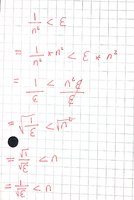Some basic algebra students learn that to solve an equation like "x+ 4= 6" you "move the 4 to the other side of the equation and it becomes negative": x= 6- 4= 2. I hate that wording because then they solve "2x= 4" saying "you move the 2 to the other side of the equation and it becomes negative": x= 4/(-2)= -2. Of course, that is incorrect because 2(-2)= -4, not 4.
What they should learn is "the opposite of adding is subtracting and the opposite of multiplying is dividing so you undo an addition by subtracting and you undo a multiplication by dividing".
"I tried different ways of solving, but I don't even understand how can you move \(\displaystyle n^2\) to the other side without even being negative."
You don't "move \(\displaystyle x^2\) to the other side" and there is no "negative" involved here! To solve
\(\displaystyle \frac{1}{n^2}< \epsilon\), since 1 is divided by \(\displaystyle n^2\) and the opposite of dividing is multiplying, you need to multiply both sides by the positive number \(\displaystyle n^2\) to get \(\displaystyle 1< n^2\epsilon\). And then, since \(\displaystyle n^2\) is multiplied by \(\displaystyle \epsilon\) you need to divide by it: \(\displaystyle \frac{1}{\epsilon}< n^2\).
Frankly, if you want to learn Calculus it looks like you will have relearn a lot of algebra! Some of what you have "learned", "I tried different ways of solving, but I don't even understand how can you move n2n2 to the other side without even being negative" , simply isn't true!

